display Seat Leon 5D 2013 Workshop Manual
[x] Cancel search | Manufacturer: SEAT, Model Year: 2013, Model line: Leon 5D, Model: Seat Leon 5D 2013Pages: 339, PDF Size: 4.8 MB
Page 195 of 339
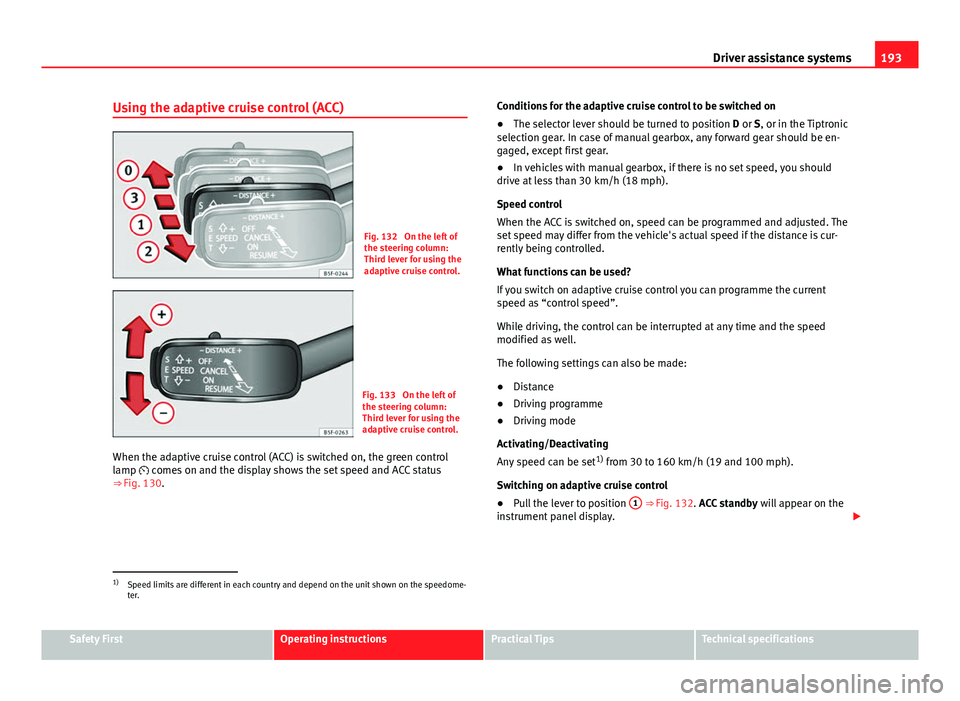
193
Driver assistance systems
Using the adaptive cruise control (ACC)
Fig. 132 On the left of
the steering column:
Third lever for using the
adaptive cruise control.
Fig. 133 On the left of
the steering column:
Third lever for using the
adaptive cruise control.
When the adaptive cruise control (ACC) is switched on, the green control
lamp comes on and the display shows the set speed and ACC status
⇒ Fig. 130. Conditions for the adaptive cruise control to be switched on
●
The selector lever should be turned to position D or S, or in the Tiptronic
selection gear. In case of manual gearbox, any forward gear should be en-
gaged, except first gear.
● In vehicles with manual gearbox, if there is no set speed, you should
drive at less than 30 km/h (18 mph).
Speed control
When the ACC is switched on, speed can be programmed and adjusted. The
set speed may differ from the vehicle's actual speed if the distance is cur-
rently being controlled.
What functions can be used?
If you switch on adaptive cruise control you can programme the current
speed as “control speed”.
While driving, the control can be interrupted at any time and the speed
modified as well.
The following settings can also be made:
● Distance
● Driving programme
● Driving mode
Activating/Deactivating
Any speed can be set 1)
from 30 to 160 km/h (19 and 100 mph).
Switching on adaptive cruise control
● Pull the lever to position 1
⇒ Fig. 132. ACC standby
will appear on the
instrument panel display.
1)
Speed limits are different in each country and depend on the unit shown on the speedome-
ter.
Safety FirstOperating instructionsPractical TipsTechnical specifications
Page 196 of 339
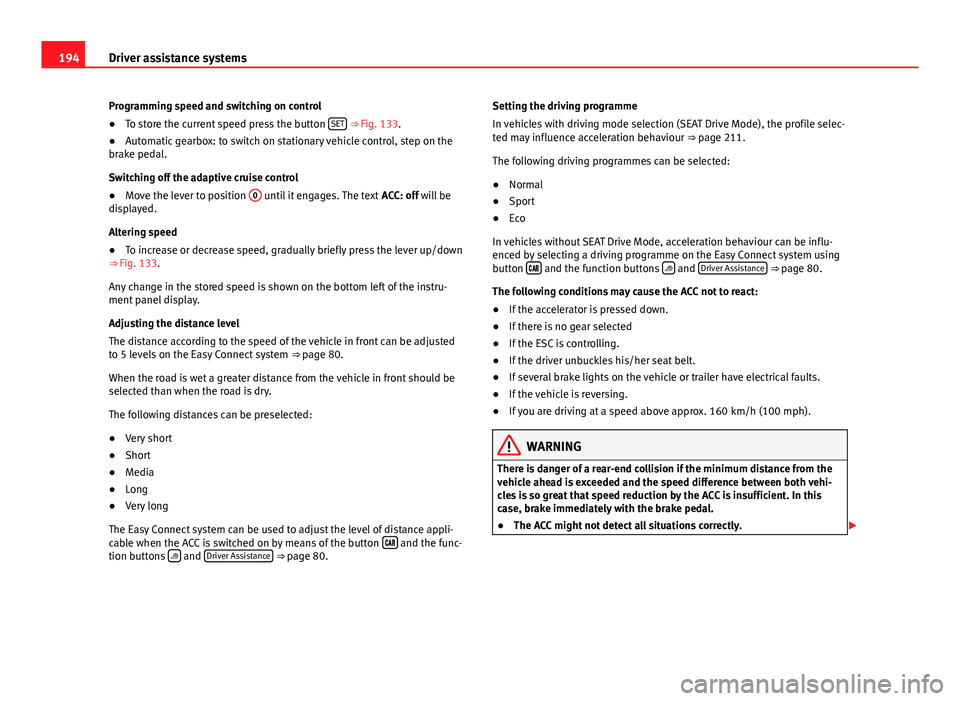
194Driver assistance systems
Programming speed and switching on control
● To store the current speed press the button SET
⇒ Fig. 133.
● Automatic gearbox: to switch on stationary vehicle control, step on the
brake pedal.
Switching off the adaptive cruise control
● Move the lever to position 0
until it engages. The text
ACC: off will be
displayed.
Altering speed
● To increase or decrease speed, gradually briefly press the lever up/down
⇒ Fig. 133.
Any change in the stored speed is shown on the bottom left of the instru-
ment panel display.
Adjusting the distance level
The distance according to the speed of the vehicle in front can be adjusted
to 5 levels on the Easy Connect system ⇒ page 80.
When the road is wet a greater distance from the vehicle in front should be
selected than when the road is dry.
The following distances can be preselected:
● Very short
● Short
● Media
● Long
● Very long
The Easy Connect system can be used to adjust the level of distance appli-
cable when the ACC is switched on by means of the button
and the func-
tion buttons and Driver Assistance ⇒ page 80. Setting the driving programme
In vehicles with driving mode selection (SEAT Drive Mode), the profile selec-
ted may influence acceleration behaviour
⇒ page 211.
The following driving programmes can be selected:
● Normal
● Sport
● Eco
In vehicles without SEAT Drive Mode, acceleration behaviour can be influ-
enced by selecting a driving programme on the Easy Connect system using
button
and the function buttons and Driver Assistance ⇒ page 80.
The following conditions may cause the ACC not to react:
● If the accelerator is pressed down.
● If there is no gear selected
● If the ESC is controlling.
● If the driver unbuckles his/her seat belt.
● If several brake lights on the vehicle or trailer have electrical faults.
● If the vehicle is reversing.
● If you are driving at a speed above approx. 160 km/h (100 mph).
WARNING
There is danger of a rear-end collision if the minimum distance from the
vehicle ahead is exceeded and the speed difference between both vehi-
cles is so great that speed reduction by the ACC is insufficient. In this
case, brake immediately with the brake pedal.
● The ACC might not detect all situations correctly.
Page 198 of 339
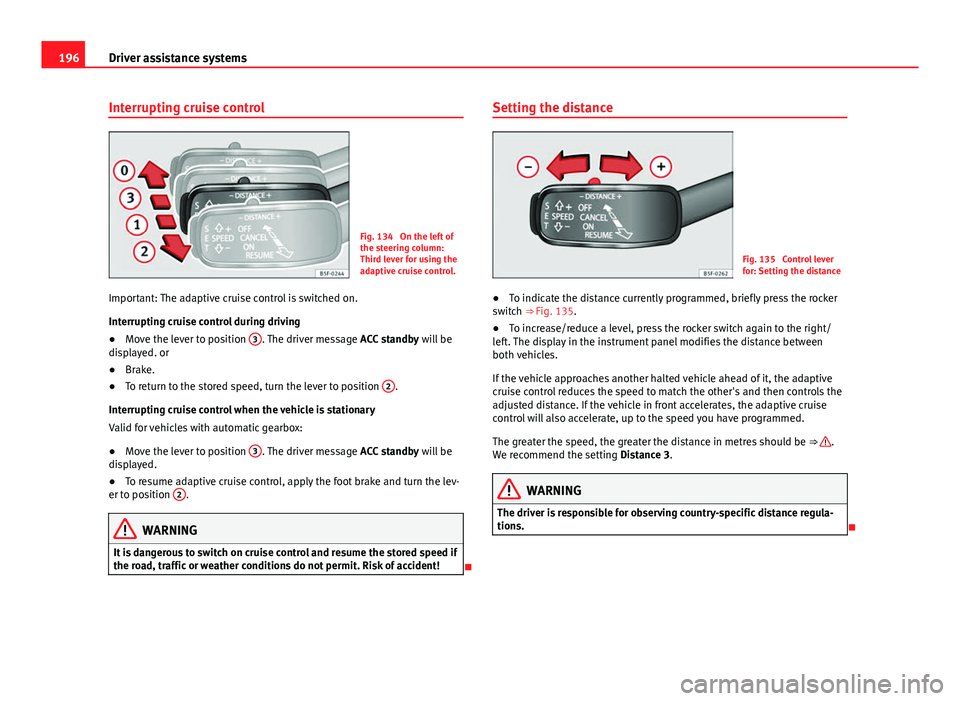
196Driver assistance systems
Interrupting cruise control
Fig. 134 On the left of
the steering column:
Third lever for using the
adaptive cruise control.
Important: The adaptive cruise control is switched on.
Interrupting cruise control during driving
● Move the lever to position 3
. The driver message
ACC standby will be
displayed. or
● Brake.
● To return to the stored speed, turn the lever to position 2
.
Interrupting cruise control when the vehicle is stationary
Valid for vehicles with automatic gearbox:
● Move the lever to position 3
. The driver message
ACC standby will be
displayed.
● To resume adaptive cruise control, apply the foot brake and turn the lev-
er to position 2
.
WARNING
It is dangerous to switch on cruise control and resume the stored speed if
the road, traffic or weather conditions do not permit. Risk of accident!
Setting the distance
Fig. 135 Control lever
for: Setting the distance
● To indicate the distance currently programmed, briefly press the rocker
switch ⇒ Fig. 135.
● To increase/reduce a level, press the rocker switch again to the right/
left. The display in the instrument panel modifies the distance between
both vehicles.
If the vehicle approaches another halted vehicle ahead of it, the adaptive
cruise control reduces the speed to match the other's and then controls the
adjusted distance. If the vehicle in front accelerates, the adaptive cruise
control will also accelerate, up to the speed you have programmed.
The greater the speed, the greater the distance in metres should be ⇒
.
We recommend the setting Distance 3.
WARNING
The driver is responsible for observing country-specific distance regula-
tions.
Page 199 of 339
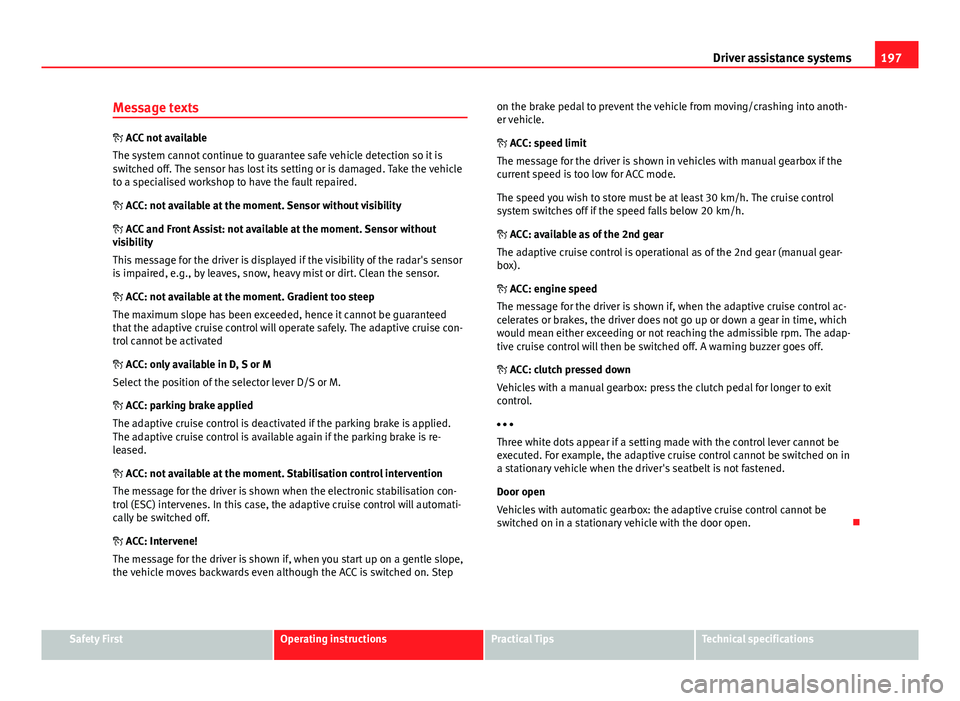
197
Driver assistance systems
Message texts
ACC not available
The system cannot continue to guarantee safe vehicle detection so it is
switched off. The sensor has lost its setting or is damaged. Take the vehicle
to a specialised workshop to have the fault repaired.
ACC: not available at the moment. Sensor without visibility
ACC and Front Assist: not available at the moment. Sensor without
visibility
This message for the driver is displayed if the visibility of the radar's sensor
is impaired, e.g., by leaves, snow, heavy mist or dirt. Clean the sensor.
ACC: not available at the moment. Gradient too steep
The maximum slope has been exceeded, hence it cannot be guaranteed
that the adaptive cruise control will operate safely. The adaptive cruise con-
trol cannot be activated
ACC: only available in D, S or M
Select the position of the selector lever D/S or M.
ACC: parking brake applied
The adaptive cruise control is deactivated if the parking brake is applied.
The adaptive cruise control is available again if the parking brake is re-
leased.
ACC: not available at the moment. Stabilisation control intervention
The message for the driver is shown when the electronic stabilisation con-
trol (ESC) intervenes. In this case, the adaptive cruise control will automati-
cally be switched off.
ACC: Intervene!
The message for the driver is shown if, when you start up on a gentle slope,
the vehicle moves backwards even although the ACC is switched on. Step on the brake pedal to prevent the vehicle from moving/crashing into anoth-
er vehicle.
ACC: speed limit
The message for the driver is shown in vehicles with manual gearbox if the
current speed is too low for ACC mode.
The speed you wish to store must be at least 30 km/h. The cruise control
system switches off if the speed falls below 20 km/h.
ACC: available as of the 2nd gear
The adaptive cruise control is operational as of the 2nd gear (manual gear-
box).
ACC: engine speed
The message for the driver is shown if, when the adaptive cruise control ac-
celerates or brakes, the driver does not go up or down a gear in time, which
would mean either exceeding or not reaching the admissible rpm. The adap-
tive cruise control will then be switched off. A warning buzzer goes off.
ACC: clutch pressed down
Vehicles with a manual gearbox: press the clutch pedal for longer to exit
control.
Three white dots appear if a setting made with the control lever cannot be
executed. For example, the adaptive cruise control cannot be switched on in
a stationary vehicle when the driver's seatbelt is not fastened.
Door open
Vehicles with automatic gearbox: the adaptive cruise control cannot be
switched on in a stationary vehicle with the door open.
Safety FirstOperating instructionsPractical TipsTechnical specifications
Page 202 of 339
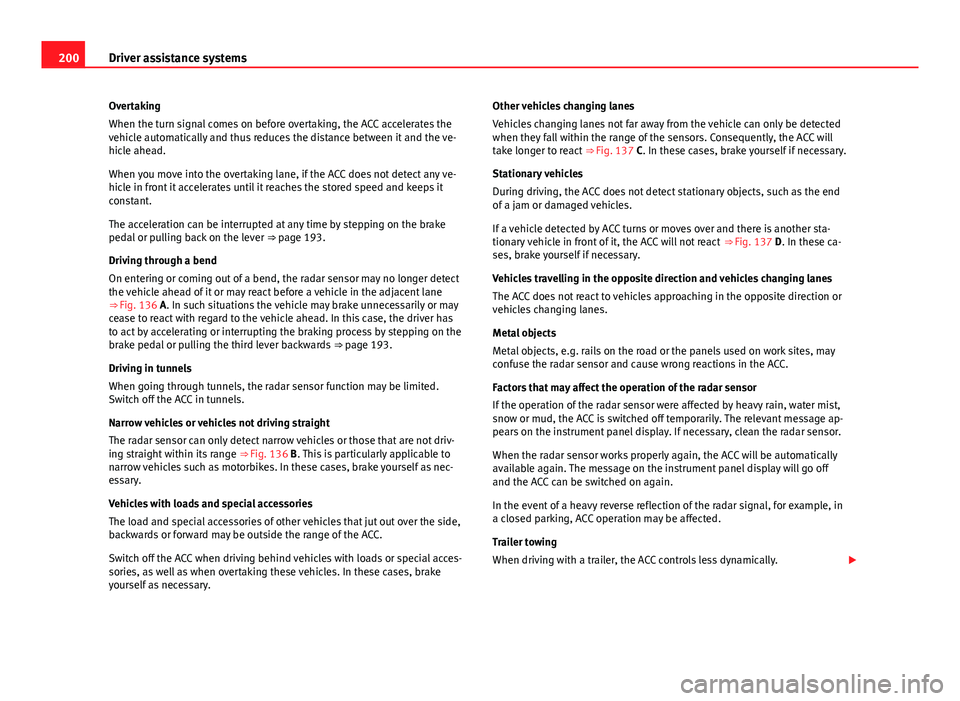
200Driver assistance systems
Overtaking
When the turn signal comes on before overtaking, the ACC accelerates the
vehicle automatically and thus reduces the distance between it and the ve-
hicle ahead.
When you move into the overtaking lane, if the ACC does not detect any ve-
hicle in front it accelerates until it reaches the stored speed and keeps it
constant.
The acceleration can be interrupted at any time by stepping on the brake
pedal or pulling back on the lever ⇒ page 193.
Driving through a bend
On entering or coming out of a bend, the radar sensor may no longer detect
the vehicle ahead of it or may react before a vehicle in the adjacent lane
⇒ Fig. 136 A. In such situations the vehicle may brake unnecessarily or may
cease to react with regard to the vehicle ahead. In this case, the driver has
to act by accelerating or interrupting the braking process by stepping on the
brake pedal or pulling the third lever backwards ⇒ page 193.
Driving in tunnels
When going through tunnels, the radar sensor function may be limited.
Switch off the ACC in tunnels.
Narrow vehicles or vehicles not driving straight
The radar sensor can only detect narrow vehicles or those that are not driv-
ing straight within its range ⇒ Fig. 136 B. This is particularly applicable to
narrow vehicles such as motorbikes. In these cases, brake yourself as nec-
essary.
Vehicles with loads and special accessories
The load and special accessories of other vehicles that jut out over the side,
backwards or forward may be outside the range of the ACC.
Switch off the ACC when driving behind vehicles with loads or special acces-
sories, as well as when overtaking these vehicles. In these cases, brake
yourself as necessary. Other vehicles changing lanes
Vehicles changing lanes not far away from the vehicle can only be detected
when they fall within the range of the sensors. Consequently, the ACC will
take longer to react
⇒ Fig. 137 C. In these cases, brake yourself if necessary.
Stationary vehicles
During driving, the ACC does not detect stationary objects, such as the end
of a jam or damaged vehicles.
If a vehicle detected by ACC turns or moves over and there is another sta-
tionary vehicle in front of it, the ACC will not react ⇒ Fig. 137 D. In these ca-
ses, brake yourself if necessary.
Vehicles travelling in the opposite direction and vehicles changing lanes
The ACC does not react to vehicles approaching in the opposite direction or
vehicles changing lanes.
Metal objects
Metal objects, e.g. rails on the road or the panels used on work sites, may
confuse the radar sensor and cause wrong reactions in the ACC.
Factors that may affect the operation of the radar sensor
If the operation of the radar sensor were affected by heavy rain, water mist,
snow or mud, the ACC is switched off temporarily. The relevant message ap-
pears on the instrument panel display. If necessary, clean the radar sensor.
When the radar sensor works properly again, the ACC will be automatically
available again. The message on the instrument panel display will go off
and the ACC can be switched on again.
In the event of a heavy reverse reflection of the radar signal, for example, in
a closed parking, ACC operation may be affected.
Trailer towing
When driving with a trailer, the ACC controls less dynamically.
Page 203 of 339
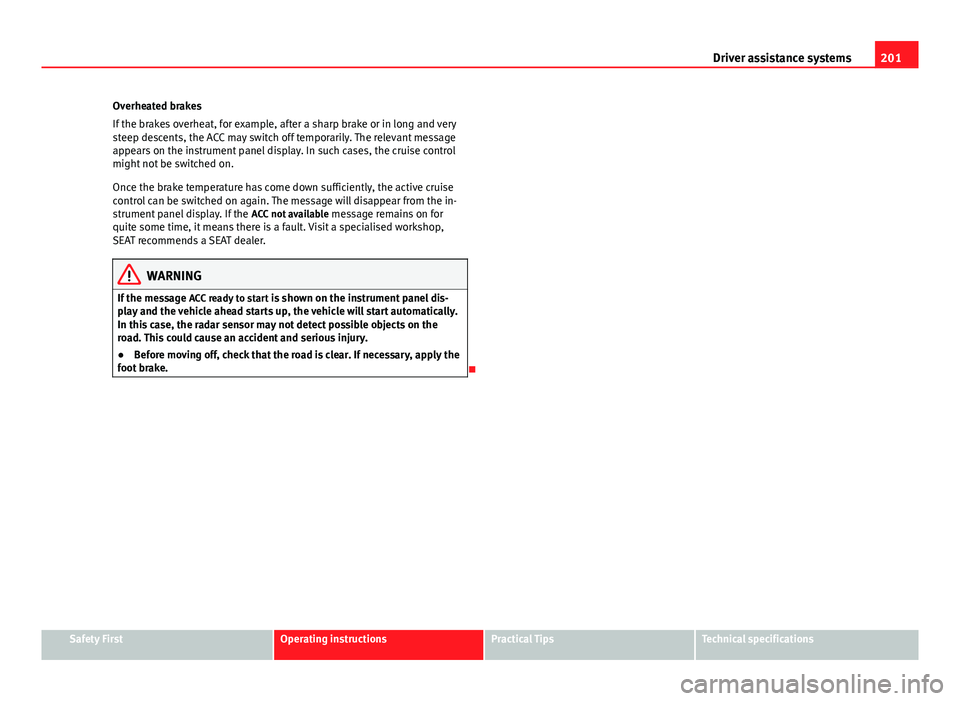
201
Driver assistance systems
Overheated brakes
If the brakes overheat, for example, after a sharp brake or in long and very
steep descents, the ACC may switch off temporarily. The relevant message
appears on the instrument panel display. In such cases, the cruise control
might not be switched on.
Once the brake temperature has come down sufficiently, the active cruise
control can be switched on again. The message will disappear from the in-
strument panel display. If the ACC not available message remains on for
quite some time, it means there is a fault. Visit a specialised workshop,
SEAT recommends a SEAT dealer.
WARNING
If the message ACC ready to start is shown on the instrument panel dis-
play and the vehicle ahead starts up, the vehicle will start automatically.
In this case, the radar sensor may not detect possible objects on the
road. This could cause an accident and serious injury.
● Before moving off, check that the road is clear. If necessary, apply the
foot brake.
Safety FirstOperating instructionsPractical TipsTechnical specifications
Page 204 of 339
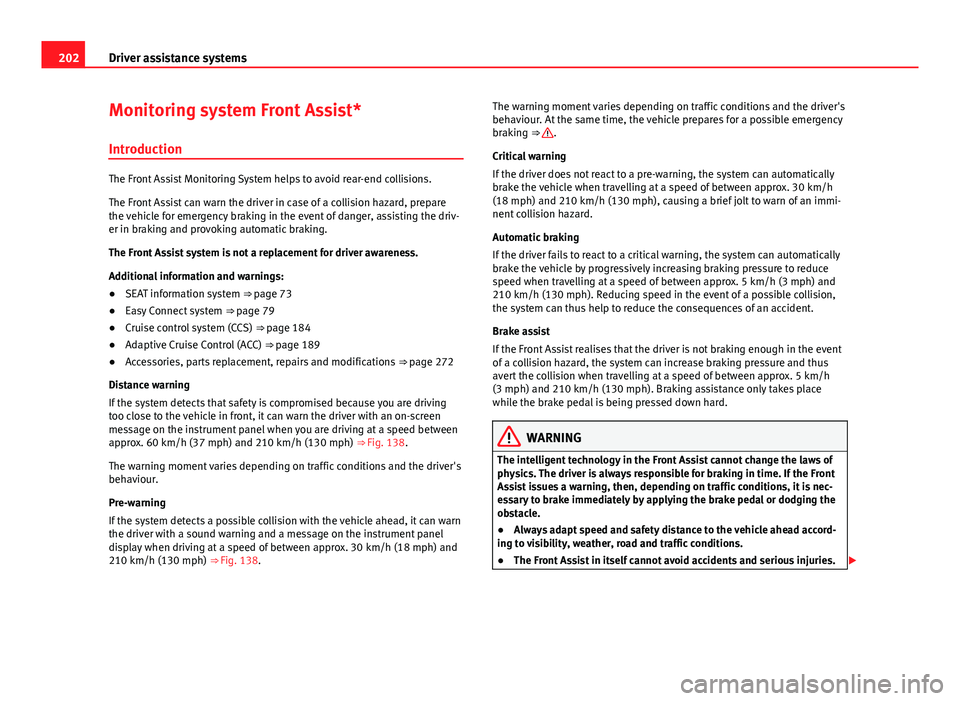
202Driver assistance systems
Monitoring system Front Assist*
Introduction
The Front Assist Monitoring System helps to avoid rear-end collisions.
The Front Assist can warn the driver in case of a collision hazard, prepare
the vehicle for emergency braking in the event of danger, assisting the driv-
er in braking and provoking automatic braking.
The Front Assist system is not a replacement for driver awareness.
Additional information and warnings:
● SEAT information system ⇒ page 73
● Easy Connect system ⇒ page 79
● Cruise control system (CCS) ⇒ page 184
● Adaptive Cruise Control (ACC) ⇒ page 189
● Accessories, parts replacement, repairs and modifications ⇒ page 272
Distance warning
If the system detects that safety is compromised because you are driving
too close to the vehicle in front, it can warn the driver with an on-screen
message on the instrument panel when you are driving at a speed between
approx. 60 km/h (37 mph) and 210 km/h (130 mph) ⇒ Fig. 138.
The warning moment varies depending on traffic conditions and the driver's
behaviour.
Pre-warning
If the system detects a possible collision with the vehicle ahead, it can warn
the driver with a sound warning and a message on the instrument panel
display when driving at a speed of between approx. 30 km/h (18 mph) and
210 km/h (130 mph) ⇒ Fig. 138. The warning moment varies depending on traffic conditions and the driver's
behaviour. At the same time, the vehicle prepares for a possible emergency
braking ⇒
.
Critical warning
If the driver does not react to a pre-warning, the system can automatically
brake the vehicle when travelling at a speed of between approx. 30 km/h
(18 mph) and 210 km/h (130 mph), causing a brief jolt to warn of an immi-
nent collision hazard.
Automatic braking
If the driver fails to react to a critical warning, the system can automatically
brake the vehicle by progressively increasing braking pressure to reduce
speed when travelling at a speed of between approx. 5 km/h (3 mph) and
210 km/h (130 mph). Reducing speed in the event of a possible collision,
the system can thus help to reduce the consequences of an accident.
Brake assist
If the Front Assist realises that the driver is not braking enough in the event
of a collision hazard, the system can increase braking pressure and thus
avert the collision when travelling at a speed of between approx. 5 km/h
(3 mph) and 210 km/h (130 mph). Braking assistance only takes place
while the brake pedal is being pressed down hard.
WARNING
The intelligent technology in the Front Assist cannot change the laws of
physics. The driver is always responsible for braking in time. If the Front
Assist issues a warning, then, depending on traffic conditions, it is nec-
essary to brake immediately by applying the brake pedal or dodging the
obstacle.
● Always adapt speed and safety distance to the vehicle ahead accord-
ing to visibility, weather, road and traffic conditions.
● The Front Assist in itself cannot avoid accidents and serious injuries.
Page 205 of 339
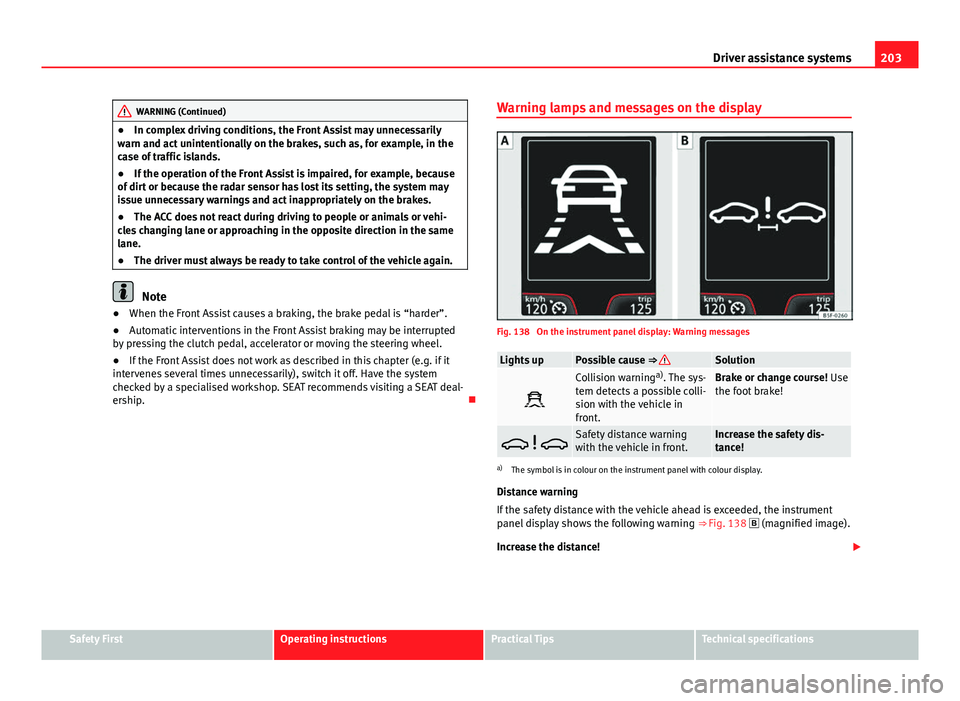
203
Driver assistance systems
WARNING (Continued)
● In complex driving conditions, the Front Assist may unnecessarily
warn and act unintentionally on the brakes, such as, for example, in the
case of traffic islands.
● If the operation of the Front Assist is impaired, for example, because
of dirt or because the radar sensor has lost its setting, the system may
issue unnecessary warnings and act inappropriately on the brakes.
● The ACC does not react during driving to people or animals or vehi-
cles changing lane or approaching in the opposite direction in the same
lane.
● The driver must always be ready to take control of the vehicle again.
Note
● When the Front Assist causes a braking, the brake pedal is “harder”.
● Automatic interventions in the Front Assist braking may be interrupted
by pressing the clutch pedal, accelerator or moving the steering wheel.
● If the Front Assist does not work as described in this chapter (e.g. if it
intervenes several times unnecessarily), switch it off. Have the system
checked by a specialised workshop. SEAT recommends visiting a SEAT deal-
ership. Warning lamps and messages on the display
Fig. 138 On the instrument panel display: Warning messages
Lights upPossible cause ⇒ Solution
Collision warning
a)
. The sys-
tem detects a possible colli-
sion with the vehicle in
front.Brake or change course! Use
the foot brake!
Safety distance warning
with the vehicle in front.Increase the safety dis-
tance!
a) The symbol is in colour on the instrument panel with colour display.
Distance warning
If the safety distance with the vehicle ahead is exceeded, the instrument
panel display shows the following warning ⇒ Fig. 138
(magnified image).
Increase the distance!
Safety FirstOperating instructionsPractical TipsTechnical specifications
Page 206 of 339
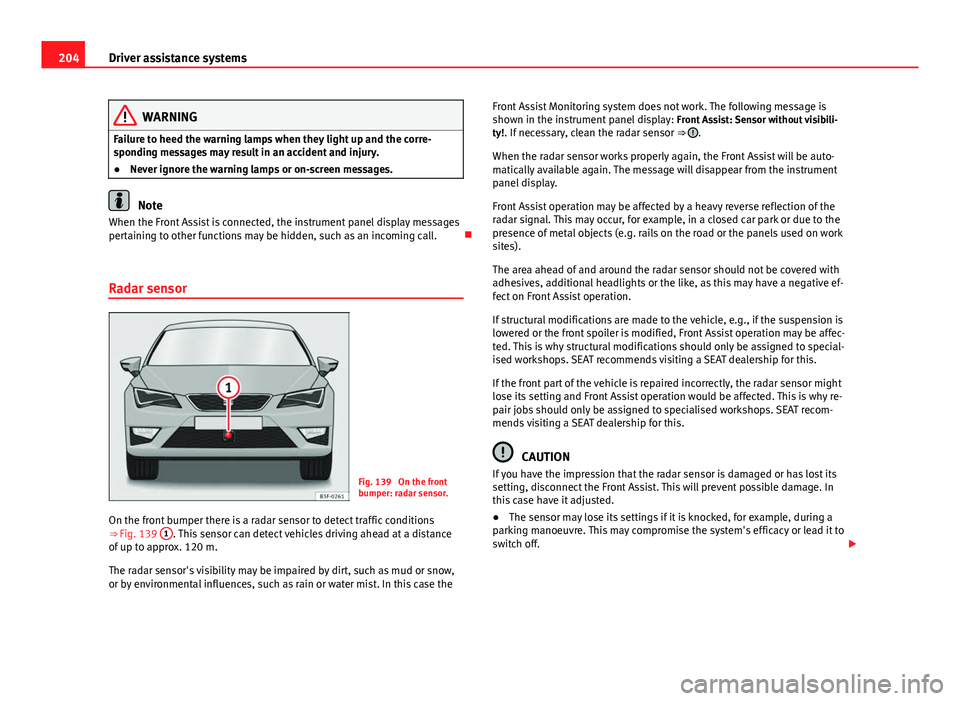
204Driver assistance systems
WARNING
Failure to heed the warning lamps when they light up and the corre-
sponding messages may result in an accident and injury.
● Never ignore the warning lamps or on-screen messages.
Note
When the Front Assist is connected, the instrument panel display messages
pertaining to other functions may be hidden, such as an incoming call.
Radar sensor
Fig. 139 On the front
bumper: radar sensor.
On the front bumper there is a radar sensor to detect traffic conditions
⇒ Fig. 139 1
. This sensor can detect vehicles driving ahead at a distance
of up to approx. 120 m.
The radar sensor's visibility may be impaired by dirt, such as mud or snow,
or by environmental influences, such as rain or water mist. In this case the Front Assist Monitoring system does not work. The following message is
shown in the instrument panel display:
Front Assist: Sensor without visibili-
ty!. If necessary, clean the radar sensor ⇒
.
When the radar sensor works properly again, the Front Assist will be auto-
matically available again. The message will disappear from the instrument
panel display.
Front Assist operation may be affected by a heavy reverse reflection of the
radar signal. This may occur, for example, in a closed car park or due to the
presence of metal objects (e.g. rails on the road or the panels used on work
sites).
The area ahead of and around the radar sensor should not be covered with
adhesives, additional headlights or the like, as this may have a negative ef-
fect on Front Assist operation.
If structural modifications are made to the vehicle, e.g., if the suspension is
lowered or the front spoiler is modified, Front Assist operation may be affec-
ted. This is why structural modifications should only be assigned to special-
ised workshops. SEAT recommends visiting a SEAT dealership for this.
If the front part of the vehicle is repaired incorrectly, the radar sensor might
lose its setting and Front Assist operation would be affected. This is why re-
pair jobs should only be assigned to specialised workshops. SEAT recom-
mends visiting a SEAT dealership for this.
CAUTION
If you have the impression that the radar sensor is damaged or has lost its
setting, disconnect the Front Assist. This will prevent possible damage. In
this case have it adjusted.
● The sensor may lose its settings if it is knocked, for example, during a
parking manoeuvre. This may compromise the system's efficacy or lead it to
switch off.
Page 207 of 339
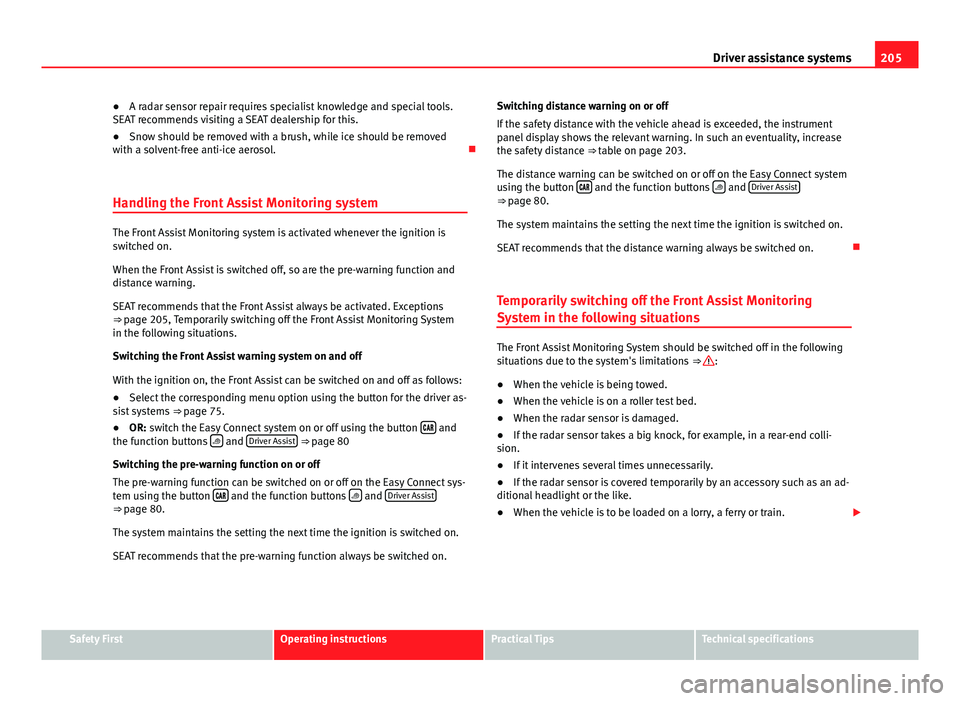
205
Driver assistance systems
● A radar sensor repair requires specialist knowledge and special tools.
SEAT recommends visiting a SEAT dealership for this.
● Snow should be removed with a brush, while ice should be removed
with a solvent-free anti-ice aerosol.
Handling the Front Assist Monitoring system
The Front Assist Monitoring system is activated whenever the ignition is
switched on.
When the Front Assist is switched off, so are the pre-warning function and
distance warning.
SEAT recommends that the Front Assist always be activated. Exceptions
⇒ page 205, Temporarily switching off the Front Assist Monitoring System
in the following situations.
Switching the Front Assist warning system on and off
With the ignition on, the Front Assist can be switched on and off as follows:
● Select the corresponding menu option using the button for the driver as-
sist systems ⇒ page 75.
● OR: switch the Easy Connect system on or off using the button
and
the function buttons and Driver Assist ⇒ page 80
Switching the pre-warning function on or off
The pre-warning function can be switched on or off on the Easy Connect sys-
tem using the button
and the function buttons and Driver Assist⇒
page 80.
The system maintains the setting the next time the ignition is switched on.
SEAT recommends that the pre-warning function always be switched on. Switching distance warning on or off
If the safety distance with the vehicle ahead is exceeded, the instrument
panel display shows the relevant warning. In such an eventuality, increase
the safety distance
⇒ table on page 203.
The distance warning can be switched on or off on the Easy Connect system
using the button
and the function buttons and Driver Assist⇒ page 80.
The system maintains the setting the next time the ignition is switched on.
SEAT recommends that the distance warning always be switched on.
Temporarily switching off the Front Assist Monitoring
System in the following situations
The Front Assist Monitoring System should be switched off in the following
situations due to the system's limitations ⇒ :
● When the vehicle is being towed.
● When the vehicle is on a roller test bed.
● When the radar sensor is damaged.
● If the radar sensor takes a big knock, for example, in a rear-end colli-
sion.
● If it intervenes several times unnecessarily.
● If the radar sensor is covered temporarily by an accessory such as an ad-
ditional headlight or the like.
● When the vehicle is to be loaded on a lorry, a ferry or train.
Safety FirstOperating instructionsPractical TipsTechnical specifications